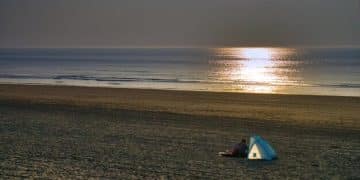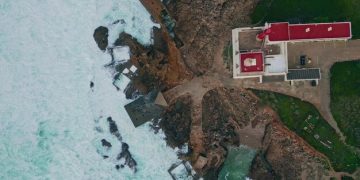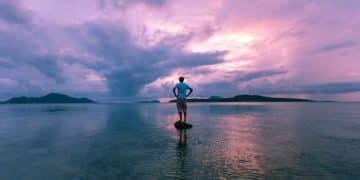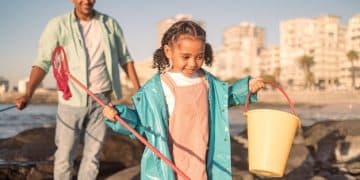Beach Camping Essentials: Your Ultimate Packing Guide for a Coastal Overnight Stay
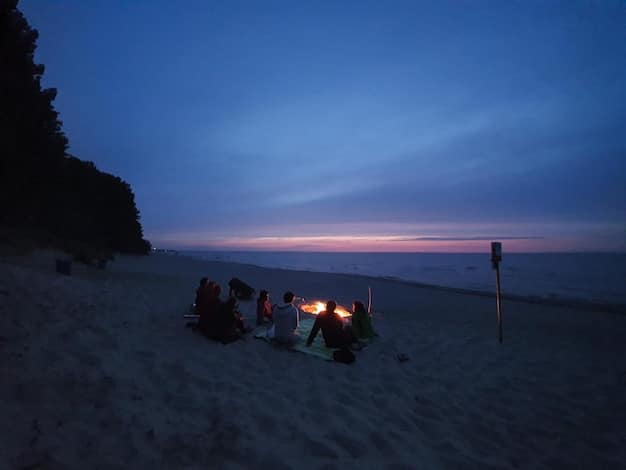
A successful overnight beach camping experience demands a meticulously prepared packing list, encompassing shelter, comfort, safety, and sustenance, to ensure enjoyment and readiness for various coastal conditions.
Embarking on a beach camping adventure offers a unique blend of tranquility and natural beauty, but it also presents its own set of challenges. To truly savor the experience and ensure a comfortable and safe overnight stay, a comprehensive understanding of Beach Camping Essentials: A Comprehensive Packing List for a Comfortable Overnight Stay is paramount. This guide will meticulously detail every item you might need, transforming a potentially daunting task into an exciting preparation for an unforgettable seaside escape.
Shelter and Comfort: Your Beach Oasis
Creating a comfortable and secure shelter is the cornerstone of any successful beach camping trip. The right gear not only protects you from the elements but also transforms your campsite into a truly relaxing oasis. Understanding the nuances of each item will significantly enhance your experience.
Tent Selection and Setup
Choosing the right tent for beach camping requires considering more than just size. Look for tents with robust poles that can withstand strong coastal winds and a good ventilation system to prevent condensation and keep the interior cool. A tent with a full rainfly is essential, even if clear skies are predicted, as unexpected showers or morning dew can quickly dampen your spirits. Practice setting up your tent at home beforehand to ensure a smooth process on the beach, especially if you arrive close to sunset.
When pitching your tent, consider the terrain. While soft sand might seem inviting, it can shift, making stabilization tricky. Look for slightly firmer, higher ground to avoid potential high tides and to ensure better drainage if it rains. Anchor your tent securely using sand stakes or by burying deadman anchors (sacks filled with sand) to prevent it from blowing away.
- Wind-resistant design: Look for aerodynamic shapes and multiple guy lines.
- Good ventilation: Mesh panels and multiple vents are crucial for airflow.
- Waterproof fly and floor: High hydrostatic head ratings (e.g., 2000mm+) ensure dryness.
- Sand stakes or anchors: Essential for securing your tent in loose sand.
Sleeping Systems for Sandy Shores
Awake refreshed and ready for beach activities by investing in a quality sleeping system. The sand, while soft, can get cold overnight, and uneven terrain can lead to discomfort. A good sleeping pad provides insulation and cushioning, while a sleeping bag appropriate for coastal temperatures will keep you warm without overheating.
Consider an inflatable sleeping pad for maximum comfort and insulation from the cool sand. Air mattresses can also be comfortable, but they can be bulky and require a pump. For sleeping bags, even in warmer climates, nighttime temperatures on the beach can drop significantly, so opt for a bag with a comfort rating that allows for some flexibility, perhaps around 40-50°F (5-10°C) or lower if camping in cooler seasons.
Don’t forget a comfortable pillow—an inflatable one or even a stuff sack filled with clothes can work. Liners for sleeping bags can add extra warmth or act as a standalone sleeping sheet on very warm nights, keeping your sleeping bag cleaner in sandy conditions.
Chairs, Tables, and Beach Blankets
Beyond the basics of sleeping, bringing comfortable seating and surfaces can significantly elevate your beach camping experience. Lightweight, foldable chairs designed for beach use (with wide feet to prevent sinking) are ideal for lounging and enjoying the sunset. A small, collapsible table provides a convenient surface for meals, games, or simply keeping items off the sand.
Large, sand-resistant beach blankets or tarps are indispensable. They create a clean, comfortable, communal space for relaxing, eating, or just protecting your gear from sand and moisture. Choose materials that are easy to shake clean and dry quickly. Some blankets come with corner pockets that can be filled with sand for anchoring, a simple yet effective feature.
Having a designated clean space minimizes the amount of sand you track into your tent. These items are often overlooked but contribute greatly to the overall comfort and enjoyment of beach camping, allowing you to fully embrace the coastal environment without constantly battling the sand.
Cooking and Sustenance: Fueling Your Coastal Adventure
Proper nourishment is key to maintaining energy and enjoyment during your beach camping trip. Thoughtful meal planning and the right cooking equipment can make a significant difference, turning simple ingredients into delightful seaside feasts.
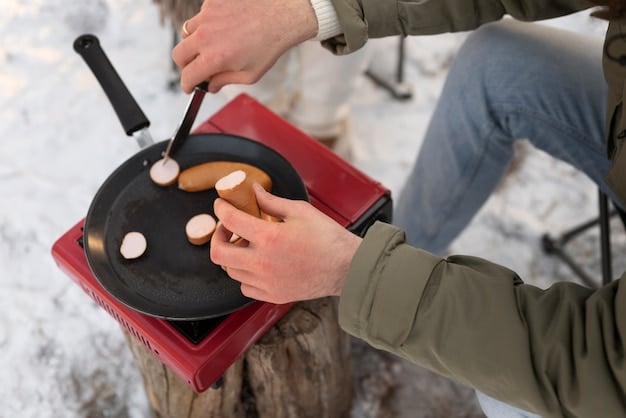
Portable Stove and Cookware
While campfires are romantic, a portable camping stove offers reliability and convenience, especially where fire restrictions apply. Look for a stove that is stable on uneven surfaces and has good wind resistance. Propane or butane-powered stoves are common and easy to use. Remember to bring enough fuel for all your planned meals.
For cookware, simplicity is key. A compact set of nested pots and pans, a spatula, and a spoon are usually sufficient. Don’t forget biodegradable soap and a small scrub brush for cleaning. Cooking on a beach can be windy, so consider a wind guard for your stove to improve efficiency and reduce cooking time. Always keep your cooking area clean and away from your tent to prevent attracting wildlife and to ensure safety.
Plan meals that require minimal ingredients and preparation. One-pot meals are excellent for camping, as they reduce the amount of dishes and complexity. Pre-chopping vegetables and mixing dry ingredients at home can save time and effort at the campsite.
Food and Water Provisions
Hydration is paramount, especially on a sunny beach. Bring plenty of water—more than you think you’ll need for drinking, cooking, and light washing. A good rule of thumb is at least 1 gallon (approximately 3.8 liters) per person per day. Consider bringing a water filter or purification tablets as a backup, especially if you have access to a freshwater source nearby (though this is rare directly on a beach).
- Non-perishable items: Pasta, rice, canned goods, dried fruits, nuts, granola bars.
- Cooler management: Use block ice or frozen water bottles to keep perishables cold longer.
- Waste management: Bring sealed bags for all food waste and packaging to pack out.
For food, focus on items that are easy to store and prepare, and that don’t require constant refrigeration. Items like instant oatmeal, dehydrated meals, and hearty sandwiches are excellent choices. If you bring perishables, a high-quality cooler with good insulation is essential. Pre-freeze items like water bottles or juice boxes to act as extra ice packs that you can consume later.
Always store food in sealed containers or bear-proof bags, especially if camping in areas known for wildlife activity. Leaving food exposed can attract animals, creating an unsafe environment and potentially leading to damage to your gear.
Dining Essentials and Cleanup
Having the right dining essentials ensures comfortable eating without excessive waste. Reusable plates, bowls, cups, and cutlery are environmentally friendly and more pleasant to use than disposable options. A dedicated wash basin or two collapsible buckets are invaluable for washing dishes on site. Remember to use only biodegradable soap and to dispose of greywater responsibly, away from water sources.
A few essential tools can make cleanup much easier: a small sponge or dishcloth, a small amount of dish soap (biodegradable is best for outdoor use), and a quick-drying towel. A small, portable clothesline can also be useful for drying towels and dishcloths. The goal is to leave no trace, so all food scraps and trash must be packed out with you.
Consider bringing a separate trash bag for recycling if facilities are available nearby. Proper waste management is not only important for preserving the environment but also for ensuring a pleasant experience for future campers and protecting local wildlife from human food interactions.
Safety and Navigation: Prepared for the Unpredictable
Beach environments, while beautiful, can be unpredictable. Being prepared for emergencies, navigating uncertain terrain, and understanding potential hazards are crucial for a safe and enjoyable trip. Never underestimate the power of the ocean or the elements.
First Aid and Emergency Preparedness
A comprehensive first aid kit is non-negotiable for any camping trip, especially on a beach where access to medical facilities might be limited. Your kit should include supplies for minor cuts, scrapes, blisters, insect bites, and sunburn. Include pain relievers, allergy medication, and any personal prescription medications. Also, consider specific items for beach-related injuries, such as sting relief medication for jellyfish or antiseptic wipes for coral cuts. For this site which is on US, include also items for dealing with heatstrokes and dehydration.
- Basic wound care: Bandages, antiseptic wipes, gauze, medical tape.
- Personal medications: Including allergy relief and pain relievers.
- Sunburn and insect bite relief: Aloe vera, hydrocortisone cream.
- Emergency blanket: For warmth in unexpected drops in temperature.
Beyond the medical kit, bring a whistle for signaling, especially if you plan to explore isolated areas. A multi-tool or knife can be invaluable for various tasks. Understanding basic first aid and knowing how to signal for help can make a critical difference in an emergency. Always inform someone of your camping plans and expected return time.
A portable power bank for charging your phone can be a lifesaver, allowing you to make emergency calls or access maps even if there’s no immediate signal. Consider a satellite messenger for truly remote locations where cell service is non-existent. These devices allow for two-way communication and SOS signaling.
Navigation and Communication Tools
Even on a seemingly straightforward beach, visibility can decrease rapidly due to fog, rain, or nightfall. A reliable GPS device or a smartphone with downloaded offline maps (and a full charge) is essential for navigation, especially if you plan to explore a long stretch of coastline or nearby trails. A physical map and compass are also wise backups, and knowing how to use them can be a crucial skill.
Communication is vital. While cell service can be spotty on beaches, having your phone fully charged and protected from sand and water damage is important. A waterproof case is highly recommended. Consider a walkie-talkie set if you are camping with a group and plan to spread out, as they don’t rely on cell signals.
Portable weather radios can provide crucial updates on rapidly changing coastal weather conditions, which can shift dramatically and quickly. Be aware of tide charts and local warnings, as rogue waves or rapidly incoming tides can be dangerous. Always know your nearest escape route if a storm approaches.
Lighting and Site Safety
As darkness falls, adequate lighting becomes crucial for safety and convenience. Headlamps are superior to flashlights as they keep your hands free, which is particularly useful for tasks like cooking, setting up camp in the dark, or navigating uneven terrain. Bring extra batteries, as cold temperatures can reduce battery life.
A lantern for your tent or communal area provides ambient light, making it more comfortable for reading, playing games, or socializing. Solar-powered lanterns are an environmentally friendly option that can charge during the day. Consider stringing up some battery-operated fairy lights around your tent for a festive and welcoming ambiance.
Beyond lighting, practice good site safety. Keep your tent clear of sharp objects. Store food away from your sleeping area to deter animals. Be aware of your surroundings, especially if strong winds are present, and secure anything that could blow away. In coastal areas, be mindful of local marine life and avoid disturbing nesting areas for birds or sea turtles, especially at night.
Personal Essentials and Recreation: Enjoying the Beach Life
Beyond the practicalities of survival and shelter, a successful beach camping trip is about enjoying the unique environment. Packing personal items that enhance comfort, protect you from the elements, and facilitate recreation will complete your experience.
Sun Protection and Personal Hygiene
The sun on the beach can be intense, even on cloudy days. Adequate sun protection is paramount. Pack a high-SPF sunscreen (at least SPF 30, preferably higher) and apply it liberally and often. A wide-brimmed hat and UV-protective sunglasses are also essential for shielding your face and eyes. Lightweight, long-sleeved clothing made from UPF-rated fabric can provide excellent additional protection without making you feel hot.
Staying clean on the beach can be a challenge, but good hygiene is important for comfort and health. Pack biodegradable soap, a small towel, and hand sanitizer. Wet wipes are invaluable for quick clean-ups when water is scarce. A small, quick-drying towel is practical. Consider a portable shower or a large jug of water for rinsing off sand and saltwater, especially before entering your tent, which greatly reduces sand accumulation inside.
Don’t forget lip balm with SPF, as lips can burn easily. Insect repellent is also highly recommended, especially during dawn and dusk hours, when mosquitoes and other biting insects can be most active near coastal vegetation.
Appropriate Clothing and Footwear
Layering is key for beach camping, as temperatures can fluctuate significantly between day and night. Pack lightweight, quick-drying clothing suitable for warm daytime temperatures, but also include warmer layers for cooler evenings. A light waterproof jacket is a wise addition, even if the forecast is clear, as coastal showers can be sudden.
For footwear, waterproof sandals or water shoes are excellent for navigating the wet sand and shallow water. Closed-toe shoes, like sturdy sneakers or hiking sandals, are advisable if you plan on exploring nearby dunes or rocky areas. Remember to pack extra socks, as wet feet can quickly become uncomfortable or prone to blisters.
Swimwear is, of course, essential for enjoying the ocean. A quick-drying towel specifically for swimming, distinct from your personal hygiene towel, is also highly useful. Even if you plan on spending most of your time barefoot, always have dedicated camp shoes to keep the sand out of your sleeping area.
Recreational Gear and Entertainment
The beach offers endless opportunities for recreation. Don’t forget items that will enhance your enjoyment of the environment. A good book, playing cards, or a portable speaker (used respectfully, considering other campers) can provide entertainment during downtime or on a rainy afternoon.
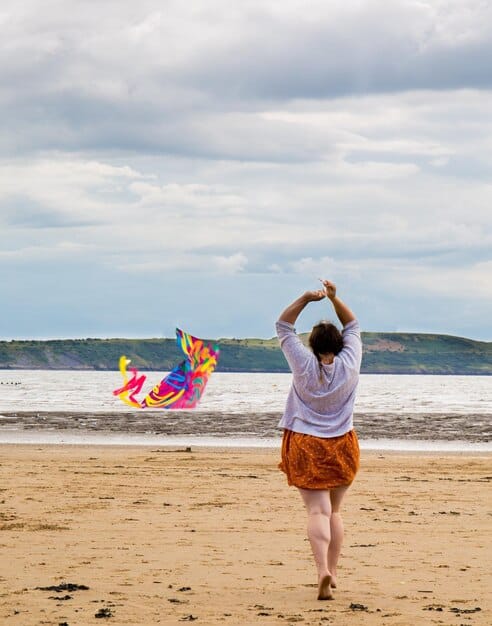
For active fun, consider a frisbee, a football, or even a small inflatable boogie board or paddleboard if conditions allow and you have space to transport it. Snorkeling gear can open up a whole new underwater world directly offshore. For photography enthusiasts, a waterproof camera or a reliable phone with a waterproof case can capture stunning coastal memories without fear of damaging your equipment.
Even a simple beach ball can provide hours of fun. If traveling with children, pack beach toys like buckets and shovels. These items contribute significantly to the overall enjoyment and relaxation of your beach camping experience, allowing you to fully immerse yourself in the coastal lifestyle.
Responsible Camping: Leave No Trace
The beauty of beach camping lies in its pristine natural environment. It is every camper’s responsibility to preserve this beauty for future generations. Adhering to Leave No Trace principles is not just a suggestion but a critical ethical guideline for any outdoor activity.
Minimizing Environmental Impact
Every action you take while beach camping has an impact on the delicate coastal ecosystem. Stick to designated camping areas to avoid damaging vegetation or disturbing wildlife habitats. Avoid trampling on dunes, which are vital for coastal protection and home to many species. Respect local wildlife by observing from a distance and never feeding animals, as this can alter their natural behaviors and health.
- Stay on established paths: Protect fragile dune ecosystems.
- Respect wildlife: Observe from a distance, never feed animals.
- Minimize noise pollution: Maintain a quiet environment for wildlife and other campers.
- Use existing fire rings (if allowed): Or pack out all ash completely.
When collecting firewood (if fires are permitted), only gather dead and downed wood that is smaller than your wrist. Never break branches off live trees. These practices ensure minimal disturbance to the local ecosystem and help maintain the natural balance of the beach environment. Remember that some beaches have strict regulations regarding fires, so always check local guidelines before your trip.
Be mindful of your waste. Collect all trash, even small pieces, and pack it out with you. This includes food scraps, which can attract unwanted animals and are not natural to the beach environment. Consider packing out more than you packed in, picking up any litter you find. The goal is to leave the campsite in better condition than you found it.
Waste Management and Sanitation
Proper waste management is perhaps the most critical aspect of Leave No Trace. “Pack it in, pack it out” applies to everything, including human waste if there are no facilities. If using a toilet, bury human waste in a Cathole at least 6-8 inches deep and 200 feet from water sources, trails, and campsites. If camping directly on a beach, often times you are requested to pack out human waste as sand does not decompose waste efficiently.
For dishwashing, use biodegradable soap sparingly and away from water sources. Disperse rinse water over a wide area to minimize impact. Avoid washing directly in the ocean or any freshwater sources to prevent contamination. Even biodegradable soaps can harm aquatic life if concentrated in bodies of water.
Carry durable trash bags to collect all your waste, including food scraps, wrappers, and hygiene products. Double-bagging can help contain odors and prevent leaks. Consider separating recyclables if facilities are available. The aim is to leave absolutely no trace of your presence, ensuring the beach remains pristine for others and for its natural inhabitants.
Understanding and Adhering to Regulations
Before embarking on your beach camping trip, thoroughly research and understand all local regulations. These can vary significantly from one beach to another and often include restrictions on fires, allowable camping areas, pet policies, and quiet hours. Many beaches require permits for overnight camping, and some may have seasonal closures or restrictions to protect wildlife, such as nesting birds or sea turtles.
Always respect posted signs and ranger instructions. These rules are in place to protect both the natural environment and the safety of visitors. Ignoring regulations can lead to fines, eviction, or even permanent damage to sensitive ecosystems. Being informed and compliant ensures a harmonious experience for everyone.
Check tide charts rigorously. Tides can come in faster and higher than anticipated, especially during full moons or storm surges, potentially flooding your campsite or trapping you. Knowing the tide schedule allows you to pitch your tent safely above the high tide line and plan your activities around the ocean’s rhythm. A responsible camper is a well-informed camper who prioritizes safety and environmental stewardship.
Planning for Success: Pre-Trip Preparations
A successful beach camping trip hinges on thorough pre-trip planning. From choosing the right location to ensuring your gear is in top condition, these preparations lay the groundwork for an enjoyable and comfortable experience.
Choosing Your Beach Camping Destination
Not all beaches are suitable for camping. Some may have restrictions, while others might lack necessary facilities or be exposed to extreme weather. Research potential campsites thoroughly. Look for designated beach camping areas that offer amenities like restrooms, fresh water access, and trash disposal, if those are important to you. Consider accessibility – how far will you have to carry your gear from your vehicle?
Check for crowd levels, especially during peak seasons. A less crowded beach might offer a more serene experience. Evaluate the local environment: are there any unique hazards like strong currents, dangerous marine life, or specific regulations regarding campfires or shell collecting? User reviews and official park websites are excellent resources for gathering this information.
Also, consider the type of sand – fine, soft sand can be challenging for tent stakes, while coarse, pebbly beaches might require extra padding for comfort. The ideal beach camping spot balances beauty, accessibility, and safety, aligning with your personal preferences for amenities and solitude.
Weather and Tide Considerations
Coastal weather can be famously fickle. Before your trip, monitor the forecast closely, not just for temperature and precipitation, but also for wind speeds and direction. Strong winds can make tent pitching difficult and bring blowing sand. Be prepared for sudden changes, as a sunny morning can quickly turn into a windy or rainy afternoon. Pack appropriate gear for multiple scenarios.
- Check wind forecasts: High winds can be challenging for tents and discomforting.
- Monitor precipitation: Essential for selecting waterproof gear.
- Consult tide charts: Crucial for tent placement and safety from high tide lines.
- Be aware of storm warnings: Have an evacuation plan if severe weather is predicted.
Tide charts are arguably the most critical aspect of beach camping safety. Always pitch your tent well above the high tide line, and be aware of king tides or storm surges that can bring water much higher than usual. Tides can also affect access to certain areas of the beach, so plan your activities and routes accordingly. A clear understanding of tidal patterns will prevent your campsite from being submerged or your gear being swept away.
Also, inquire about general coastal hazards. Rip currents are a common danger, so know how to identify them and what to do if caught in one. Be mindful of marine life that might be present, such as jellyfish or stingrays, and know how to treat potential stings. Preparedness for these natural phenomena ensures a safer and more relaxed camping experience.
Gear Maintenance and Test Runs
Before packing your gear, take the time to inspect everything. Check your tent for holes, faulty zippers, or bent poles. Ensure your sleeping pad holds air and your stove functions correctly. There’s nothing worse than arriving at your campsite only to discover critical equipment is broken or missing. Perform any necessary repairs or replacements well in advance of your trip.
For new gear, or if you’re a first-time camper, conduct a test run at home. Set up your tent in your backyard to familiarize yourself with the process. Try cooking a simple meal on your portable stove. This practice will build your confidence and help you identify any missing items or unforeseen challenges, making your actual beach trip much smoother and more enjoyable.
Charge all batteries—for headlamps, lanterns, phones, and power banks. Pack extra batteries or find solar-powered alternatives. Ensure your first aid kit is fully stocked and up to date. This meticulous attention to detail in the planning phase vastly improves the likelihood of a comfortable, enjoyable, and incident-free beach camping adventure.
| Key Item | Brief Description |
|---|---|
| ⛺️ Tent & Anchors | Essential for shelter, opt for wind-resistant designs with strong anchoring in sand. |
| 💧 Water & Cooler | Crucial for hydration and preserving food freshness in coastal heat. |
| ☀️ Sun Protection | High SPF sunscreen, hats, and UV-protective clothing are crucial for beach exposure. |
| 🩹 First Aid Kit | Comprehensive kit for common injuries, including those specific to beach environments. |
Frequently Asked Questions
▼
For beach camping, a tent with robust poles and strong guy lines is crucial to withstand coastal winds. Look for models designed for three-season use or specific wind resistance. Good ventilation is also key to mitigate condensation in high humidity. Ensure it has a reliable rainfly and reinforce anchoring with sand stakes or deadman anchors for security.
▼
Minimizing sand in your tent requires conscious effort. Use a doormat outside your tent, establish a “no-sand” zone for shoes, and wear minimal clothing inside. Consider a small broom or dustpan for quick cleanups. Rinsing off with a portable shower or water jug before entering your tent can significantly reduce sand tracked inside, preserving your comfort.
▼
Essential cooking items include a portable camping stove with adequate fuel, a compact cookware set (pot, pan), and basic utensils like a spatula and spoon. Don’t forget biodegradable soap and a small scrub brush for cleaning. A wind guard is highly recommended for efficient cooking in breezy conditions, protecting your flame and heat.
▼
A good rule of thumb is to bring at least 1 gallon (approximately 3.8 liters) of water per person per day for drinking, cooking, and minimal hygiene. Always pack more than you anticipate needing, especially in warm, sunny conditions. Consider backup purification methods or a water filter if you have access to a potable water source nearby for emergencies.
▼
No, campfires are not allowed on all beaches. Regulations vary widely by location due to fire risk, environmental protection, and local ordinances. Always check the specific rules and regulations of your chosen beach or park before planning to have a campfire. If allowed, use existing fire rings and ensure the fire is completely extinguished before leaving.
Conclusion
A well-planned beach camping trip, equipped with the right essentials, transforms a simple overnight stay into a memorable adventure. By prioritizing shelter, sustenance, safety, and responsible practices, you can fully embrace the unique beauty and tranquility of the coastline. Meticulous preparation, from selecting robust gear to understanding local regulations, ensures not only your comfort but also the preservation of these precious natural environments for generations to come. Embrace the surf, sand, and stars with confidence and preparedness, making your beach camping experience truly unforgettable.
